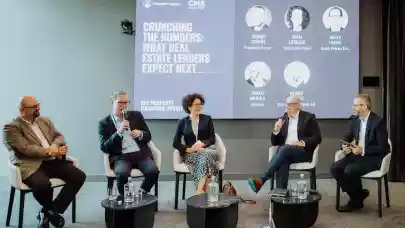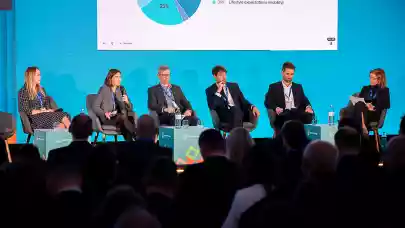
At the recent CEE Property Financing Update 2025, organised by Property Forum and CMS Poland, an expert panel convened to dissect the dynamics shaping real estate lending in CEE. Moderated by Csanád Csürös, CEO of Property Forum, and featuring insights from Beata Latoszek (Deutsche Hypo), Dieter Lobnig (Bank Pekao S.A.), Tomasz Niewola (mBank), and Hannes Wimmer (Erste Group Bank AG), the discussion illuminated the strategic responses of top lenders to evolving macroeconomic and market conditions.
The conversation quickly turned to competition and market share. Dieter Lobnig captured the challenges facing domestic banks amid an influx of international capital: “We’ve maintained a commanding presence in corporate banking, yet in real estate our share lags below 10% because of the sheer volume of international players. The environment in CEE—and especially in Poland—is among the most competitive, not only due to euro-denominated transactions but because international developers bring their own banks and structures, changing the risk landscape and intensifying the race for deals.”
For Beata Latoszek, the competitive environment goes hand in hand with hard-won stability and sector adaptation. “There’s no real lull in activity—on the contrary, competition has only intensified, with more banks chasing the same high-quality projects, particularly in Warsaw and large regional cities. What stands out is not just the sheer busyness, but that investors are now more willing to close deals and accept prices, making the market healthier and more dynamic than it has been in the recent past,” Latoszek explained, emphasising the shifting balance between investment lending and construction finance.
Tomasz Niewola contributed a pragmatic banking perspective, noting the positive undercurrents during a period marked by global volatility. “From the vantage point of Polish banks, capital flows may be less global, but regional players are stepping up, and the stability of our sector is an anchor. The cumulative effect of geopolitical developments, from demographics to defence spending, has actually buoyed the Polish economy and positioned our sector for resilience and potential growth,” Niewola commented, highlighting the role of opportunistic capital and increasing trading activity among investors.
Hannes Wimmer brought a cross-border lens, observing that “the tide appears to be turning, with the office and retail markets rebounding in Western Europe and more domestic capital circulating within the EU. Transaction volumes remain below historic highs, but sentiment is improving—valuations are stabilising and we’re beginning to see capital move from maturing CEE funds into new regional opportunities, particularly in the living and logistics sectors.” He also acknowledged that while development lending remains a minority focus, the right projects in the right contexts are still being financed.
The panel explored the polarisation of the property market: prime assets easily attract bank funding, while secondary or older buildings face tighter refinancing criteria and must increasingly show energy efficiency or alignment with ESG (Environmental, Social, and Governance) requirements. As Lobnig pointed out, “Retail parks are increasingly favoured for their resilience and stable cash flow, but older assets in regional cities must innovate or risk being left behind by both lenders and investors.”
A lively discussion of sustainability ensued, foregrounding both the regulatory drivers and the practical business case for ESG in lending decisions. “ESG is embedded in our credit processes, not as a headline topic but as a critical factor in underwriting and non-financial reporting,” noted Niewola, with panellists remarking on the growing importance of energy efficiency for asset value and competitiveness. While regulatory progress and document requirements remain challenges, cooperation between banks and clients is fueling a gradual, practical shift toward greener portfolios.
In closing, the panellists agreed that while uncertainties remain—ranging from potential monetary easing to the impact of upcoming mergers and regulatory decisions—the fundamentals of the CEE real estate market remain strong.




